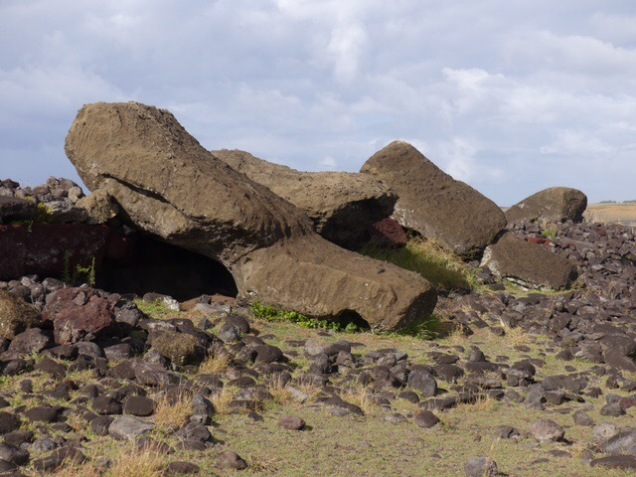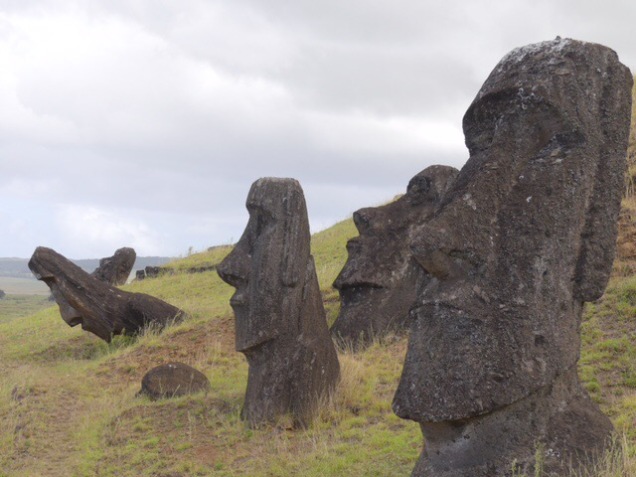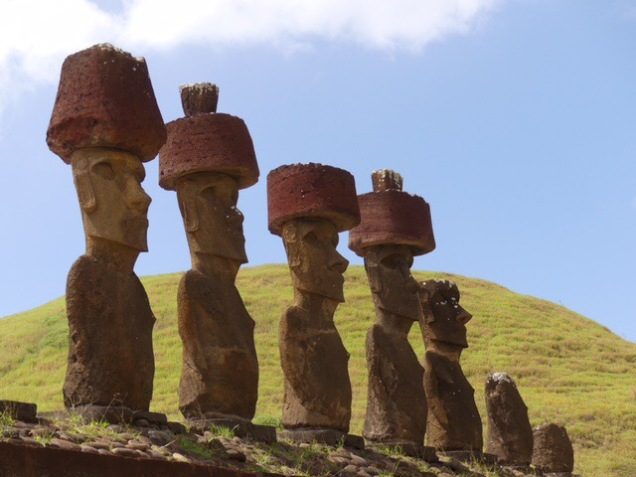Iorana! Here we go with Choco’s top tips for visiting Rapa Nui. I don’t need to list the best archaeological sites to see – there’s plenty of info out there on that – but my personal thoughts on making the most of your trip. Tip Zero, obviously, is GO! It’s the most unique place, with a fascinating fusion of ancient and modern, RapaNui, Polynesian & Latin American cultures, set in an equally awe inspiring landscape.

1. Push the boat right out, and give it at least a whole week, or more! I was there 8 days and it still didn’t feel long enough. It’s the most remote inhabited island in the world, you’ve probably paid a fair bit just to get there, so why not take enough time to really enjoy it. English travel groups notoriously try to squeeze it all into a three-day tour package – yes, you can see all the highlights, but you’ll probably be so busy racing from site to site, there’ll be almost no time to just let Rapa Nui soak into your skin.
2. Make yourself independent with a copy of James Grant-Peterken’s excellent A Companion to Easter Island – especially if you are, like me, more inclined to independent discovery than being bussed around on a tour. I found it an invaluable friend, from history to best times of day to visit the busier sites to walks and restaurant recommendations. James lives on the island, he knows what he’s talking about. My now very dog eared copy was boughtbefore travelling, but there’s a kindle edition now, andgift shops on the island sell it.
3. Get ready to spend (and save) money – Easter Island’s isolation means it’s not cheap but it IS DEFINITELY worth saving for! It’s US$60/CLP54,000 just to enter the national park, food and accommodation are not cheap. I saved by staying in a hostal with guest kitchen, then bought eggs, cheese, yoghurt, bread and fruit for breakfasts and packed lunch. There are some good smaller cafes offering menu del día options for less than £10, including good fresh fish dishes. And for a cheap filler, no-one quite makes a queso-atún empanada quite like Tía Berta – Rapa Nui’s best pasty is filling and cheap, oozing with cheese, onions and juicy fresh tuna. Delicious!
4. Get some wheels. It’s really worth hiring a car, a scooter, a quad bike etc, and avoid the crowds by visiting the best sites in the early morning and late afternoon when the light will show off their better features, as well as taking you to the beach, or for some great walks. Its particularly worth making sure your visit to Rano Raraku is early morning (go after the sunrise at Tongariki maybe), before the tour buses arrive. You can hire a pedal bike, but three separate people I met did that for one day, then traded up to a scooter! If hiring an vehicle it’s definitely worth shopping around as prices can vary, and deals can be struck.
5. Eat the raw fish, drink the pisco! Easter Island has some truly great restaurants, specialising in fish and seafood (I particularly liked Te Moana and Haka Honu, both in the harbour area). I have never tasted such fresh, delicious raw tuna and sea bass in my life, and here it comes in vast portions, often plentiful enough for two to share with an additional side dish. There are plenty of variations of marination and the Moai sunset bar at Tahai also does some good spin in a pisco sour with a great view of the Moai to round off your day.

6. Go crater crawling. If visiting the volcano at Ranu Kau and Orongo, it’s really worth the 1-2 hour walk around the crater edge to the far side of Kari Kari (ie. opposite direction from Orongo). The spectacular view of the crater, with the precariously perched village, the sheer cliffs and the jagged motus poking out of the bluest sea, is really not something you want to miss.

7. See the sun rise at Tongariki. On Easter Island, it ain’t much of a hardship to get up before dawn because in order to synchronise office hours with Santiago, island time runs just two hours behind Chile mainland time. At the time I was there the sunrise was about 8.15 – with the skies turning peachy pink and orange a little before that. The shimmering shards of golden light behind the 15 giant moai is truly a sight to behold.

8. For the best sense of just how isolated the island is, and a breathtaking 360 view of the whole island and its craters and crags, take a morning to climb Mount Terevaka. It’s a relatively easy walk (just wear a hat and take water!), mostly on grassy track, about 1.5-2 hours up and a bit less to get down again, so up to 4 hours total. There is nothing but nothing but sparkling blue ocean all around. So. Much. Ocean.

9. Bring, beg, borrow or buy a snorkel and mask, so you can check out the underwater life, especially the array of interesting fish and giant turtles. A family of the latter almost daily hangs out amongst the boats in the harbour, catching the fish heads and scraps from the fisherpeople. Just check out my Chilean friend Christian’s one minute video and you’ll see what I mean. At Ovahe and Anakena beaches the areas by the rocks are where the interesting fish lurk.

10. See a show! I went to see Kari Kari, the most established professional group on the island, conveniently with its own venue just across the road from my hostel Inaki Uhi. Tickets there were CLP15,000 (around £19 at the time of travel). It was packed with great, and quite revealing traditional costumes and accompanied by ukuleles, drums, conch shells and heartily sung harmonies, the whole show was full of life, sexy & cheesily cheeky, all around entertaining and just put a smile on my face and the sunshine into my heart.
I could go on with recommendations! I haven’t even mentioned the two lovely beaches at Anakena and Ovahe, for example! Or Terangi, a great guide who works for Rapanui tours. If you’ve been to Easter Island, I’d love to know what you think, and please add your own highlights in the comments section! If you’re thinking of going there, and want to know more, get in touch!





















